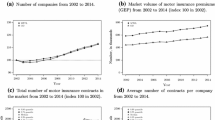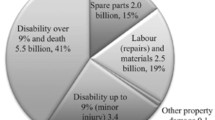Abstract
Actuarial risk classification is usually performed at a guarantee and policyholder level: for each policyholder, the claim frequencies corresponding to each guarantee are modelled in isolation, without accounting for the correlation between the different guarantees and the different policyholders from the same household. However, sometimes, a common event will trigger both guarantees at the same time. Moreover, the claim frequencies for policyholders from the same household appear to be correlated. This paper aims to supplement the standard actuarial approach by combining two guarantees and the policyholders from the household, which allows to refine the prediction on the claim frequencies and account for the common shocks on multiple guarantees. Some possible cross-selling opportunities can also be identified.






Similar content being viewed by others
References
Antonio K, Frees EW, Valdez EA (2010) A multilevel analysis of intercompany claim counts. ASTIN Bull J IAA 40(1):151–177
Antonio K, Guillén M, Pérez Martín AM et al (2010) Multidimensional credibility: a bayesian analysis of policyholders holding multiple policies. Technical report, Amsterdam School of Economics Research Institute
Antonio K, Zhang Y (2014) Nonlinear mixed models. In: Edward WF, Richard AD, Glenn M (eds) Predictive modeling applications in actuarial science of International Series on Actuarial Science, vol 1. Cambridge University Press, Cambridge, pp 398–424
Bermúdez L, Guillén M, Karlis D (2018) Allowing for time and cross dependence assumptions between claim counts in ratemaking models. Insur Math Econ 83:161–169
Bermúdez L (2009) A priori ratemaking using bivariate poisson regression models. Insur Math Econ 44(1):135–141
Bermúdez L, Karlis D (2011) Bayesian multivariate poisson models for insurance ratemaking. Insur Math Econ 48(2):226–236
Bermúdez L, Karlis D (2012) A finite mixture of bivariate poisson regression models with an application to insurance ratemaking. Comput Stat Data Anal 56(12):3988–3999
Denuit M, Maréchal X, Pitrebois S, Walhin J-F (2007) Risk classification, credibility and bonus-malus systems. Actuarial modelling of claim counts. Wiley, Hoboken
Eddelbuettel D, François R (2011) Rcpp: seamless R and C++ integration. J Stat Softw 40(8):1–18
Englund M, Guillén M, Gustafsson J, Nielsen LH, Nielsen JP (2008) Multivariate latent risk: a credibility approach. ASTIN Bull 38(1):137–146
Englund M, Gustafsson J, Nielsen JP, Thuring F (2009) Multidimensional credibility with time effects: An application to commercial business lines. J Risk Insur 76(2):443–453
Frees EW, Jin X, Lin X (2013) Actuarial applications of multivariate two-part regression models. Ann Actuar Sci 7(2):258–287
Frees EW, Lee G, Yang L (2016) Multivariate frequency-severity regression models in insurance. Risks. https://doi.org/10.3390/risks4010004
Frees EW, Wang P (2006) Copula credibility for aggregate loss models. Insur Math Econ 38(2):360–373
Pechon F, Trufin J, Denuit M (2018) Multivariate modelling of household claim frequencies in motor third-party liability insurance. ASTIN Bull 48(3):969–993
Pinquet J (1998) Designing optimal bonus-malus systems from different types of claims. ASTIN Bull 28(2):205–220
Shi P, Feng X, Boucher J-P (2016) Multilevel modeling of insurance claims using copulas. Ann Appl Stat 10(2):834–863
Shi P, Valdez EA (2014) Multivariate negative binomial models for insurance claim counts. Insur Math Econ 55(1):18–29
Thuring F (2012) A credibility method for profitable cross-selling of insurance products. Ann Actuar Sci 6(1):65–75
Tuerlinckx F, Rijmen F, Verbeke G, De Boeck P (2006) Statistical inference in generalized linear mixed models: a review. Br J Math Stat Psychol 59(2):225–255
Wood SN (2017) Generalized additive models: an introduction with R, 2nd edn. CRC Press, Boca Raton
Acknowledgements
The financial support of the AXA Research Fund through the JRI project “Actuarial dynamic approach of customer in P&C” is gratefully acknowledged. We thank our colleagues from AXA Belgium, especially Arnaud Deltour, Mathieu Lambert, Alexis Platteau, Stanislas Roth and Louise Tilmant for interesting discussions that greatly contributed to the success of this research project. Also, we thank our colleagues from the SMCS, the UCLouvain platform for statistical computing, for setting us up a comfortable and efficient working environment.
Author information
Authors and Affiliations
Corresponding author
Additional information
Publisher's Note
Springer Nature remains neutral with regard to jurisdictional claims in published maps and institutional affiliations.
Appendix
Appendix
1.1 A priori model
We aim here to give more details on the a priori model that is used to estimate the a priori claim frequencies.
As explained in Sect. 3, three separate models are considered, one for each count variable. The GAMs were chosen to model the claim frequencies, using a Poisson regression with a \(\log\) link function. See Wood [21] for an introduction on GAMs. In practice, the mgcv package available in R was used. After careful variable selection, the final models were as follows:

Let us make a few comments on the models. The power variable was not significant in the two first models, probably due to the association between the covered value and the power of the vehicle. However, the covered value did not appear to be significant for the MD:TPL claims, resulting in the power variable to be significant, once the covered value variable was removed. Note that litigation24 corresponds to the variable litigation with the levels 2 and 4 merged. This has been done after a likelihood ratio test suggested both levels were not significantly different in the regression model used for the claim frequency in MD : TPL. Also, note that the functions s(.) mean that a smooth function is estimated. Finally, notice that we included the variable gender, as this modelling concerns the technical claim frequencies (not the commercial ones, for which the usage of the gender variable has been prohibited in the EU).
Due to confidentiality reasons, we cannot display the estimated claim frequencies. We can however show the relative impact of some selected variables. We show on Fig. 7 the impact of the age of the policyholder, which was estimated for both genders. Also, on Fig. 8, the geographic effect is displayed. Moreover, in what relates the categorical variables, in TPL, policyholders with new cars have about 13.6% less claims and professional usage increases by 37% the claim frequency. Litigation also increased the claim frequency.
In MD, new cars, as opposed to TPL, appeared to have a multiplicative effect of 1.59, while the professional usage increased the claim frequency by 8.5%. Again, the litigation variable showed an increase of the claim frequency when the policyholder once failed to pay its premium in due time.
In MD:TPL, policyholders with new cars also appear to have more claims (multiplicative effect of 1.15), as well as professional usage (1.15) and the litigation variable. Finally, cars with higher power have also an increase of the claim frequency (1.23).
1.2 Numerical integration using GHQ
We provide hereafter a short sensitivity analysis of the numerical integration using the Gauss-Hermite quadrature. Using the quadrature involves choosing a number of nodes per dimension which are used to compute the integral.
On Table 7, we show the nodes per dimension (remember that for a two policyholders’ household, the contribution to the likelihood involves the computation of a six-dimensional integral), and the obtained maximum likelihood estimators. For the three-dimensional integrals (i.e., for the households with only one policyholder), we fixed the number of nodes per dimension to 10, meaning that the three-dimensional integrals are computed with 1,000 nodes. We observe that there is a rapid convergence. The results highlighted in this paper have been computed with 10 nodes per dimension, regardless of the number of policyholders.
Rights and permissions
About this article
Cite this article
Pechon, F., Denuit, M. & Trufin, J. Multivariate modelling of multiple guarantees in motor insurance of a household. Eur. Actuar. J. 9, 575–602 (2019). https://doi.org/10.1007/s13385-019-00201-5
Received:
Revised:
Accepted:
Published:
Issue Date:
DOI: https://doi.org/10.1007/s13385-019-00201-5






